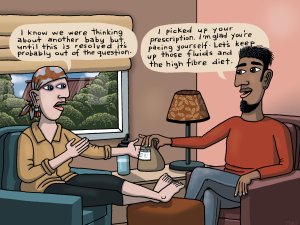Academic pharmacist Nataly Martini highlights the importance of understanding non-Hodgkin lymphoma and pharmacists’ roles in managing this condition
Pharmacies soon to access patient free-script eligibility online
Pharmacies soon to access patient free-script eligibility online

Prescription fees are back this month. Jonathan Chilton-Towle investigates what the authorities are doing to support pharmacies to administer the new targeted system
From the middle of this month, pharmacy staff will be able to check online to see whether a patient is eligible for free prescriptions under the Government’s new targeted prescription-fee scheme.
The $5 prescription fee is back for most New Zealanders from 1 July, after the Coalition Government reversed the previous Labour Government’s policy of making prescriptions universally free.
Under the new regime, prescriptions will remain free for Community Services Card and SuperGold Card holders. The prescription subsidy card, which patients become entitled to after their household has paid for 20 prescriptions in a year is also returning, as is the free prescriptions entitlement for patients aged 13 and under.
Analysis of dispensing data from the Pharmacy Guild found that approximately 83 per cent of currently dispensed prescriptions would be eligible for free prescriptions under the new targeted scheme, and pharmacists have expressed concerns about how they will determine which patients are eligible.
Te Whatu Ora confirmed last month it is working on a system that will enable pharmacists to check eligibility and this will be available to all pharmacies from 15 July.
Martin Hefford, Te Whatu Ora director, living well, says work is currently under way to give pharmacies access to the National Enrolment Service entitlements function.
The NES is a real-time patient register used by all general practices and, once pharmacies get access to it, they will be able to enter a patient’s NHI number and see if the patient has a prescription subsidy card, CSC or High Use Health Card.
“This will enable pharmacists to easily identify whether someone is a Community Services Card holder and is exempt from the $5 prescription copayment when integrated into their PhMS (pharmacy management system),” Mr Hefford says in an emailed statement.
If a prescription subsidy card has not been issued, pharmacies will need to look up the counts for each individual and their family, as was the case before fees were universally removed.
But Mr Hefford says Te Whatu Ora is also working to enable pharmacies to create and record prescription subsidy card entitlements in real time in the NES system and link individuals to their entitlement. This function is planned to come into effect from 1 February next year.
Last month, Te Whatu Ora also began a public information campaign to inform patients about the prescription-fee change.
It created and shared a series of informative posts about the change on social media channels on 18 June.
Prior to that, on 17 June, Mr Hefford says Te Whatu Ora shared messaging with the pharmacy sector to assist them with informing the public of the changes, which included an A3 poster and A5 flyer designed to use in pharmacies.
Te Whatu Ora is currently in the process of updating its website to reflect the new rules, as are Manatū Hauora the Ministry of Health, Healthify, Healthpoint and the Ministry for Social Development.
PSNZ president Michael Hammond says the society asked for the information campaign.
“Reading online comment sections shows that there are still a lot of mixed feelings about what the policy means for pharmacists, and how it impacts on them and their patients,” Mr Hammond says in a media statement.
“This is why we considered it important that the government agency implementing the policy decision provided resources to take some of the load off our members and pharmacy teams during the change process.”
Some pharmacists have been critical of the Government for bringing back the prescription fee in the middle of winter.
Te Awamutu pharmacy owner Gemma Perry, who owns Sanders Pharmacy and is a member of the Prescription Access Initiative, says returning a financial barrier to accessing medication at a time when the healthcare system is at its busiest is a bad idea.
“This is avoidable pain and distress for patients and the healthcare community,” Ms Perry says.
She believes increasing the cost for accessing medicines does not fit in with this Government’s stated goal of reducing the cost of living for New Zealanders. It will also end up costing the country more, through creating more work for other health professionals as hospitalisation rates increase due to people not picking up prescriptions they can’t afford.





